Not our Time
Date: August 2015
It’s not always easy to watch Bernard Yanelli’s new play “Not Our Time” and hear the horrible things being said about students in a public high school. But at a time when talk of a widening racial divide dominates the headlines along with cries that #BlackLivesMatter, they need to be heard, as a reminder for those who lived through the era of desegregation in the South in the late 1960s and as life lessons for those too young to remember“Not Our Time,” which won the 2014 Players Theatre New Play Festival, opened Thursday night at the community theater in a production that reveals some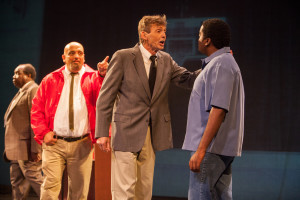 raw power in the writing and an important message to be shared. Director Carole Kleinberg has worked closely with Yanelli over the last few years to shape the script that isn’t always fully realized through the performances on stage.
raw power in the writing and an important message to be shared. Director Carole Kleinberg has worked closely with Yanelli over the last few years to shape the script that isn’t always fully realized through the performances on stage.
Though it’s not officially set in Manatee County, “Not Our Time” is a fictionalized account of the real experiences of Henry Lawrence, a standout defensive player at the all-black Palmetto Lincoln High School. But when his school was shut down and merged with the all-white Manatee High School in 1968, Lawrence spent most of the time on the bench because of coaches who were trying to promote white students, costing Henry potential scholarships. (Lawrence, who went on to 13 years with the Oakland Raiders and three Super Bowl games, attended Thursday’s premiere.)
Yanelli also aims to tell a bigger story about the different paths taken by those affected by such outright racism. Some, like Henry, moved toward the non-violent protest advocated by Dr. Martin Luther King Jr., while others, like the character of Jet, Henry’s best friend, turned to violence to make sure their voices were heard.
The play focuses on Henry, played with a kind disposition and fierce determination by Terrance Jackson, and Jet, played with a wonderful strength and energy by Jean-Paul Monde, who gets to reveal talents rarely seen in his many musical ensemble roles. A glare or a pointed finger have a lot of impact.
Their long-time Coach Moore, played with compassion by Ronn Bobb, is a sort of trusting apologist for the school system. Henry and Jet face major opposition when their new school changes coaches, substituting the supportive Coach D’Amato, played by David Yamin, for the antagonistic Coach Wicks, played with a stern ferocity by Barry Look. Wicks tries to hide his inner racism with an outward sense of support until it becomes too much to bottle in. Look can really explode, but he has moments of stiffness as if he’s reacting by rote at times.
Wicks uses his white quarterback Raine to cause problems for the black players. But we don’t get much sense of Raine’s personality from Dylan Jones, who plays him as too soft or nervous.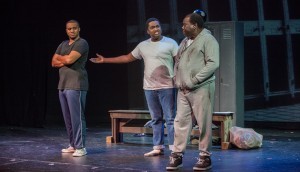
Beatrice Fletcher-Miller is kindly as a teacher who tutors and encourages Henry and tries to get through to the obstinate and angry Jet, but you also want more from her.
The play is staged on a mostly barren stage, backed by some effective projections of civil rights leaders, protests and school settings, and some actual desks or lockers that are moved on and off stage.
Kleinberg has done some nice work bringing out often compelling performances from her cast. Yanelli may be trying to do too much at times, but he has the beginnings of a play that could have some lasting impact, particularly on those who don’t remember such challenging times.
Jay Handelman
Not our Time
Date: August 2015
Before opening night, Henry Lawrence seemed a bit equivocal about “Not Our Time,” a new play about a year in his life as a Manatee County high school football player. He liked it, he said, but he called it “a start” and suggested that it needed some tweaking.
When the play got its first full staging Thursday night, almost no one seemed equivocal. People in the audience cheered and gasped as the story of Lawrence’s struggle against racism unfolded, and most of them shot to their feet at the play’s end and gave it a standing ovation.
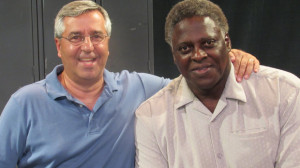 “Not Our Time” comes from local playwright Bernard Yanelli. He’s a history teacher at Bradenton’s Saint Stephen’s Episcopal School and a frequent winner of local playwriting competitions. He won the 2014 Players New Plays Festival with “Not Our Time.” It was presented in a reading then. The winning play from the each year’s festival gets a full production at the of the Players’ season. So this is the time for “Not Our Time.”
“Not Our Time” comes from local playwright Bernard Yanelli. He’s a history teacher at Bradenton’s Saint Stephen’s Episcopal School and a frequent winner of local playwriting competitions. He won the 2014 Players New Plays Festival with “Not Our Time.” It was presented in a reading then. The winning play from the each year’s festival gets a full production at the of the Players’ season. So this is the time for “Not Our Time.”
Lawrence was a football star at his segregated high school, but his career was literally sidelined when integration forced him to play for a racist coach in his senior year.
But Lawrence persevered and became an NFL star, and a key player on two Super Bowl championship teams.
“Not Our Time” starts at the end of Lawrence’s junior season, as he and his teammates celebrate their third straight undefeated season, and progresses through his disastrous season at his new school.
Yanelli produces solid characterizations that eschew stereotypes — the good guys have flaws, the bad guys have redeeming qualities — and tells Lawrence’s story in a compelling way, even though most people in the audience will know the ending.
There are times when the pace slows. Yanelli’s passion for teaching history sometimes outshines his passion for creating compelling theater, and he bogs the script with unnecessary historical background and trivia. And some of the characters undergo transformations that seem unnatural.
The Players’ production features strong acting from almost everyone in the eight-person cast, especially from Terrance Jackson as Lawrence and Jean-Paul Monde as his best friend and Dylan Jones as the quarterback of the white school.
Director Carole Kleinberg provides a pleasing pace and flow, and some really believable fight scenes.
If, as Henry Lawrence himself commented, the show is just “a start,” it’s a strong one. It’s not without its dramatic and theatrical problems, but it’s so solid that people cheer out loud for its protagonists. And maybe they even learn a little about the evolution of contemporary racism from watching Yanelli’s take on what happened in Manatee County nearly a half-century ago.
Marty ClearTheater Review: ‘Kiss the Moon, Kiss the Sun‘
Date: August 17, 2011
‘Kiss the Moon, Kiss the Sun’ is a heartwarming story about a slow-witted 35-year-old man and his effect on the life of an unmarried, pregnant young woman. Written by Canadian playwright Norm Foster, the play is about that commodity most notably on the decline in modern society: compassion. Foster is the author of nearly 50 plays, including “The Melville Boy,” which received an off-Broadway run. The audience at the Banyan Theater Company premiere laughed heartily and shed a few tears over this excellent production, which was amusing and poignant in its defense of the old-fashioned notion of our responsibilities to one another as human beings.
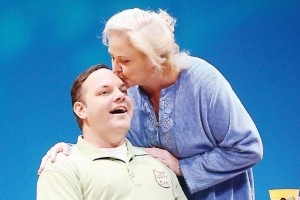 Robert David May is sympathetic and believable as Robert Castle, the mentally challenged man, who’s convinced that the weight of the iron and zinc in his cereal makes him late for the bus. May played Max Bialystock in “The Producers” and Jud in “Oklahoma!” at The Players Theatre this season. Robert Castle lives with his mother, Claire, lovably played by Karel K. Wright. Claire talks to God when Robert’s out of the room, declaring, “This may be the last time we ever speak,” if God fails to help her provide for her son after she’s gone.
Robert David May is sympathetic and believable as Robert Castle, the mentally challenged man, who’s convinced that the weight of the iron and zinc in his cereal makes him late for the bus. May played Max Bialystock in “The Producers” and Jud in “Oklahoma!” at The Players Theatre this season. Robert Castle lives with his mother, Claire, lovably played by Karel K. Wright. Claire talks to God when Robert’s out of the room, declaring, “This may be the last time we ever speak,” if God fails to help her provide for her son after she’s gone.
Wright has performed in numerous productions with the Mad Cow, Gorilla Theater and TheatreZone companies locally and with the Minnesota Repertory Theatre and the Cincinnati Playhouse in the Park. Katherine Michelle Tanner is charming and realistic as Holly Fitch, the college graduate who wants to be a teacher but so far has only been able to land a job at a sporting-goods store. Her situation becomes dire when she learns she’s pregnant. Tanner most recently played Margaret in “Charm” at Orlando Shakespeare Theatre.
The boyfriend-in-question is Holly’s self-centered former college professor. Wayne LeGette does a great job of portraying the egotistical male who is too caught up in his own world to comprehend the problems of others. LeGette co-starred on A&E’s “The Glades” and has appeared in numerous regional theater productions.
Paula AtwellKiss the Moon, Kiss the Sun
Date: August 2011
Director Carole Kleinberg makes all the right choices interpreting a script that could have focused us to “look on the sunny side” and “moon over an adorable guy with a handicap.” Instead of coming over as a story of a dying mother trying to get her mentally challenged son a keeper for when she’s gone, the Banyan production of ‘Kiss the Moon, Kiss the Sun’ centers on a choice that must be made by a young single mother.
It helps that Katherine Michelle Tanner as Holly exhibits intelligence and (give or take an understandable nail-bite or two) emotional strength throughout. With her recent education degree but only an unrelated retail job in Ontario, Holly is pregnant by her English professor and determined to have her baby. Involved in an acrimonious divorce, Simon can think only of “how difficult” his position is. (His wife’s family is his U.’s big benefactor.) After dismissing selfish Simon (handsome Wayne LeGette, crisply smug), on her way to work tearful Holly meets Robert Castle, middle-aged but mentally eight. Friendly, inquisitive, garrulous, he (Robert David May, strikingly natural, keeping his character’s quirks on the winning edge of control) initiates a mutually sympathetic friendship with Holly. Happily, humor dominates pathos in scenes to follow.
Holly seems the answer to the prayers of Robert’s long overprotective mother Claire. Afflicted with cancer and congestive heart failure, she (affecting Karel K. Wright) wants to make sure “God’s plan” for her son agrees with hers. Luckily, she has rooms once let to boarders. With bargain rent, she lures Holly, who must save money for the baby. All goes well until after baby has come. Simon returns from Hallifax to offer Holly assurance of a teaching job, a place in his home for her and his son, and the probability of marriage. Since Robert’s own father left, he has believed “everything in life leads to good-bye.” Will that be true for him once again?
Director Kleinberg deserves additional credit for her casting, from the no-nonsense Holly of Tanner to the realistic Castles’ doctor of Dan Higgs. Especially effective technically are the many, varied musical bridges between scenes and suggestive designs of seasons projected as background. Costumes establish those in addition to characterizations. The title comes from a sampler the Castles quote every day. It expresses feelings of warmth and protective care. Like what fans of The Banyan feel toward the theater company. With good reason.
Marie J KilkerDrawer Boy
July 2010
Three terrific performances make for a strong evening of theater at the Banyan Theater Company’s production of Michael Healey’s “The Drawer Boy.”
Don Walker as Morgan and Kenneth Tigar as Angus are two middle-aged farmers in Central Ontario in the summer of 1972. They’ve been friends since childhood, went to war together in World War II, and came home with two English brides, Angus with a metal plate in his head and a badly damaged memory.
They’ve lived for 30 years in a battered old farmhouse, where Angus is in charge of making sandwiches while Morgan runs the place. Their routine, which includes an almost-nightly retelling of their life story by Morgan to Angus, is disrupted with the arrival of Miles (Ken Ferrigni), part of an acting troupe from Toronto studying the lives of farmers before they put on a play.
As Miles, Ferrigni is all early-’70s scraggle, with a mop of curly red hair, those ’70s sideburns, artfully patched jeans and absolutely no idea of how a farm works. Exasperated, Morgan puts him to work washing gravel, “rotating” crops and shuffling eggs, just to keep him out of the way.
But the questions Miles asks, especially of Angus, who can’t remember Miles’ name or why he’s there from one moment to the next, begin to unravel the fiction of the farmers’ lives. Ultimately the importance of both storytelling and memory are examined.
Director Carole Kleinberg gets nuanced, subtle performances from both Walker and Tigar, but it’s really Tigar’s show, as Angus bounces between cheerful ignorance and blinding headaches that bring him literally to his knees. His delight in the mundane routine of fixing sandwiches plays against his confusion as he gropes through his unraveled memory, pulling at the thinnest of threads.
Walker epitomizes the gruff farmer who doesn’t suffer fools gladly, only to be saddled with this nitwit actor.
The action plays out against Michael Newton-Brown’s simple set that goes a step beyond a suggestions of the farmhouse and dirt yard surrounding it. Michael Pasquini’s lighting effectively captures the gorgeous sunrises and sunsets of farm country and the countless twinkling stars, while Steve Lemke’s sound design creates a chorus of cricket chirps, birdsongs and cows lowing, with evocative guitar music during the scene changes.
Susan Rife
Fiddler on the Roof
Date: March 2010
The status of Fiddler on the Roof as one of the most popular and enduring Broadway musicals of all time is unassailable—and deserved. It’s popped up frequently at community theaters around Sarasota over the years, but it’s been a while since the last visit; so the Players’ current production is a welcome one, especially judging by the packed house on opening night.
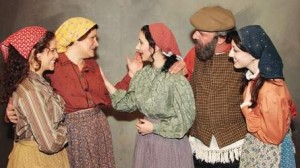 Those in attendance must have felt they got their money’s worth. There are a few not unusual quibbles about the show: As is often the case with community theater, there aren’t quite enough men of the right age and physical characteristics to go around, and on occasion the balance between the orchestra and the singers was uneven. But the pluses here outweigh the minuses.
Those in attendance must have felt they got their money’s worth. There are a few not unusual quibbles about the show: As is often the case with community theater, there aren’t quite enough men of the right age and physical characteristics to go around, and on occasion the balance between the orchestra and the singers was uneven. But the pluses here outweigh the minuses.
Among the pluses are the leads. As humble milkman Tevye, blessed and burdened with those five daughters to marry off, Leonard A. Rubinstein throws himself into the part and delivers a zestful (if not always subtly nuanced) portrayal. He’s in command of the role and the stage from that classic opening number, Tradition, and he’s backed by some strong ensemble singers. (One other quibble while we’re at it: Tevye’s signature song, If I Were A Rich Man, was played and sung too fast on opening night. Slow it down to savor all the syllables).
While Tevye is the centerpiece of this Sheldon Harnick-Jerry Bock-Joseph Stein hit, Fiddler is famous for its wealth of instantly recognizable characters, including the matchmaker Yenta (convincingly played by Betty Silberman), the butcher Lazar Wolf (ditto for Cliff Cespedes), and the three oldest daughters, Tzeitel (Libby Fleming in a sprightly turn), Hodel (Georgie Landy, also spirited) and Chava (Erin Weinberger, touching in her Act II dance). Believable characterizations are also provided by Rafael Petlock as rebellious student Perchik, Steve Jaquith as mouse-turned-man Motel, and Sandra Musicante as Grandma Tzeitel and Loryn Haber as Fruma-Sarah in the memorable dream sequence of the first act. Nancy Apatow as Golde is a good match for Rubinstein’s Tevye, and she delivers her songs well; she could use a little less gesturing with her hands at emotional moments.
Production values here are strong. There’s a set by Michael Newton-Brown that summons up that doomed village of Anatevka well and converts easily from scene to scene; costumes by Kaylene McCaw likewise clothe all those villagers appropriately for their stations in life. And the direction by Carole Kleinberg (aided by choreographer Donna Culbreth, who flexibly adapted the show’s original movements to suit this cast) is accomplished and feeling. I would only say that sometimes the pacing (even for a show that admittedly clocks in around three hours) is too rapid; perhaps that will change later in the run.
STAFFThe Drawer Boy
July 16, 2010
Some viewers may find the opening scenes of Michael Healey’s The Drawer Boy, now onstage at the Cook Theatre in a Banyan Theater production, a bit too slow and low-key for their tastes. But the quiet, measured pacing and atmosphere of this play are quite intentional; it’s one that involves you a little at a time, until you’re fully placed in the setting of a Central Ontario farmhouse and the lives of its residents.
The house (the kitchen and back yard of which are convincingly recreated in rustic manner by Michael Newton-Brown) is the longtime home of two slightly past middle age men, Morgan (Don Walker) and Angus (Kenneth Tigar). They’ve been getting by on the farm for more than 30 years, tied together in a relationship based on something that happened 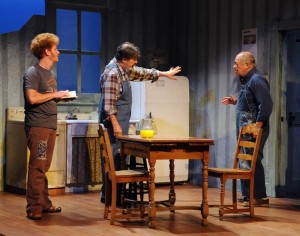 long ago, during World War II, when Angus was injured and his short-term memory was the casualty. With a steel plate in his head, no recollection of anyone but Morgan, but an amazing facility for numbers, Angus needs Morgan, who shields him from some sad truths about his condition and its effects.
long ago, during World War II, when Angus was injured and his short-term memory was the casualty. With a steel plate in his head, no recollection of anyone but Morgan, but an amazing facility for numbers, Angus needs Morgan, who shields him from some sad truths about his condition and its effects.
Enter the plot device—oops, make that the city boy—that will shake up this arrangement. Miles (Ken Ferrigni) is an earnest if not quintessentially talented actor who wants to observe life on the farm to assemble some scenes for a play. With a typical ’70s hairstyle (the play is set in 1972) and look, he’s good for some comic relief, especially as Morgan discovers how easy it is to score off him when it comes to performing needless tasks around the property. Morgan’s manner, like much of the play itself, is undemonstrative, but no less entertaining for that.
But of course the longer Miles stays, the more curious he becomes about Angus’ past. When he overhears Morgan telling Angus a pivotal story one starlit night and ends up using it in a rehearsal of his play, Morgan is angry enough to order him off the farm. But something about seeing that story performed stirs Angus’ memory. And the tension develops: Will Angus (and we) learn the truth about what happened to him, against Morgan’s protective will?
As directed by Carole Kleinberg, the three men in the cast work smoothly and believably together (even though Walker was a replacement for another actor during the rehearsal process). Ferrigni is alternately engaging and frustrating as Miles; we’re not sure just how aware he really is of Morgan’s teasing, and that’s as it should be. Walker has the dry Canadian wit necessary for Morgan, along with the gentle, firm way of dealing with Angus that reveals how much he cares about his friend. And Tigar is always involving and plausible as the frequently childlike Angus, never overdoing any of the symptoms of his affliction and gradually letting us find our way into his head and memories.
By the time you hear another version—the real one—of that story Morgan’s been telling Angus for years, your heart should be touched enough to keep these characters in your memory for some time.
Kay KiplingMoonlight and Magnolias
There is a moment during Ron Hutchinson’s enjoyable “Moonlight and Magnolias” when one character evokes the Greek philosopher Plato, whose name has become the acronym for the newly created nonprofit producing arm of the Golden Apple Dinner Theatre: Professional Learning And Theatrical Organization. “Plato says we’re like men staring at the wall, seeing flickering shadows from the fire behind us, trying to figure out what they mean,”says screenwriter Ben Hecht. “What’s that but a movie theater?”
The same can certainly be said for the offerings of a freshly minted professional stage company that provides entertaining and engaging plays such as this one.
Here’s the gist of the plot, in a nutshell: “Gone With The Wind” is in trouble. Barely weeks into production, David O. Selznick has fired his director and hired Victor Fleming off the set of “The Wizard of Oz” to take the reins. Losing $50,000 a day while the cast and crew await a new script, Selznick locks Ben Hecht, Fleming, and himself in his office for a week to come up with a new one. No one is allowed to leave and the only food available is bananas and peanuts (“brain food,” says Selznick). Hecht has never read the book, so Selznick and Fleming must act it out for him, chapter by chapter, as he translates it into a shooting script.
The plot serves as grist for a lot of funny moments such as when Selznick, as Scarlett O’Hara, delivers a baby from Melanie Wilkes, played by a writhing, undulating Fleming. Another sequence in which Scarlett slaps her maid Prissy for not coming back with help turns into a comical take on just how the slap will be filmed without the audience hating Scarlett.
The cast is exceptional. B.J. Wilkes is a convincing Hecht, Ryan Kimball Fitts’ Fleming starts out as the macho director who by week’s end is reduced to a crazed, exhausted shell of himself and Alana Opie is fun in the lesser role of the efficient, overworked secretary Miss Poppenghul. But Chris Caswell, in my favorite performance of the evening, delivers a Selznick who judiciously balances his overbearing megalomania with a genuinely admirable desire to make a movie that will stand the test of time.
Director Carole Kleinberg keeps the action moving at a zesty pace just short of farce.
Steven J. SmithCrossing Delancy
Date: November 2007
Playwright Susan Sandler’s romantic comedy “Crossing Delancey” will be presented at the Lemon Bay Playhouse through Nov. 18.
Freelance director Carole Kleinberg, whose resume includes more than 70 plays, many of which have graced noted Sarasota venues, said in her LBP director’s notes, “I fell in love with ‘Crossing Delancey’ the first time I saw it. The sweetness and charm of this play, with its richly drawn, uncannily familiar characters, tight plot, clever dialogue, fluid staging and great comedic possibilities, provide a base for us, and my talented cast filled every moment with love and insight and humor.”
The play was first produced by The Jewish Repertory Theater in 1985.
Movie buffs may remember it from the 1988 film adaptation that won lead Amy Irving a Golden Globe nomination. It has since become popular with community theaters.
The LBP production stars Echo Buchanan as Isabelle, who works in an upscale Manhattan bookstore, where she meets and becomes enamored with Tyler (Robin Mazey), a dashing author.
True to her traditional Jewish upbringing, Isabelle spends much time with her grandmother, or Bubbie, (Nina Hughes) who calls upon Hannah (Lora Resignato), a Jewish matchmaker, to find a husband worthy of her granddaughter. Hannah finds a “good catch” for Izzy — the handsome Sam (Matt Curry), a hard-working pickle-maker and vendor. The title refers to Delancey Street on New York’s Lower East Side, where the story takes place.
Marilyn D. CarpenterElephant Man
Date: November 2007
“The Elephant Man” – Des Plaines Theatre Guild Prairie Lakes Community Center (841) 391-5120′ Through July 21
There are so many places and so many ways that Bernard Pomerance’s “The Elephant Man” can go wrong. Under Carole Kleinberg’s firm-handed direction, the Des Plaines Theatre Guild misses them all, and delivers an excellent production of this very thoughtful play.
The chief pitfall to avoid in doing “The Elephant Man” is the sin of pity. The play tells the simultaneously tragic and triumphant story of John Merrick, a Victorian Englishman deformed almost beyond the power of imagination by a disorder known as Proteus Syndrome. Crippled, hideous and shunned as he is, Merrick invites pity by the boat load; but Pomerance asks us, instead, for sympathy – feeling with, not feeling sorry for. If it dips into sentimentality the play’s a goner.
Kleinberg avoids that quagmire, keeping the tone factual, even-handed, avoiding the melodrama inherent in the story. Much of this success is due to the superb performance she elicits from her lead, James Turhan Alfred, as Merrick….
It’s an actor’s commonplace that it’s easier to portray a character with a distinguishing tick or trick (a la Daniel Day Lewis in “My Left Foot,” or Tom Hanks as Forrest Gump) than it is to make a just-plain-person compelling. While Merrick’s life demands that Alfred employ some of these elements – his broken gait, the twisted facial features that burden his speech – they are merely props. They define Merrick’s obstacles, but not Alfred’s performance, the essence of which is in his readings. The physicality of his performance is important (the energetically twitching fingers which hold his cane are all the body language he can speak), but it is the simple dignity of his speech that defines the man. It is a memorable, affecting and most impressive demonstration of acting skill.
Merrick’s life and career are extraordinary, and tailor-made for a story teller. Unable to work, and with needs beyond his family’s financial and emotional means, Merrick is taken on by a grimy entrepreneur named Ross (Will Shore), who employs him as a freak show attraction. He is incidentally discovered by a rising young doctor named Frederick Treves (well-played by Bruce D. Janu). While Treves is unable to ameliorate Merrick’s physical condition, he endeavors to help him live a more human life. In a pattern we see enacted to this day, Merrick rises to the opportunity and, because of the extremity of his situation, becomes celebrated, a darling of the day’s illuminati, royalty flocking to his affliction like Hollywood personalities to the disease du jour.
While Treves is his keeper and protector, Merrick gains one true friend in the well known actress, Mrs. Kendal (portrayed with strength and heart by Cira Vance). Other notable performances include Gene Falcetta as Gomm, the head of the London Hospital, which becomes Merrick’s home; and Nina Lacelles, Molly Mulcrone and Pamela Ann Loberger, who portray a host of characters, from Merrick’s aristocratic patrons to the Belgian pinheads who are his brief acquaintances and colleagues. The versatile cast of 10 fills 30 roles, underscoring the play’s interest in questions of identity, appearance and what truly defines and composes us.
“The Elephant Man” may be a bit heavy for summer fare, but if you’re looking for a break from the surfeit of ‘splosions we’ve already been served this season, here’s your chance.
Rick MoserLerner Life
Date: November 1995
“When the ancient Greeks went to see “Oedipus” they already knew the plot. Elizabethans knew the story of “Hamlet,” and the same is true of the audience witnessing “The Diary of Anne Frank” playing at Oakton Community College Nov. 16 through 19.
What holds all these audiences is the way the story is told, the gradual unfolding of plot until the final tragedy, the interplay of character as interpreted by the actors and the director.
Carole Kleinberg is one such fine director. She has added two excellent innovations to her interpretation of “Diary.” First is her understanding and interpretation of Anne herself, often portrayed as gentle and sweet. The Oakton production gives us a vibrant, talkative youngster, almost a child with attention-deficit disorder. as she flits around the stage, restless, chatty, and – as with most adolescents throbbing with hostility toward her mother. Anne, beautifully played by Hanalori Schumacher, comes across as a real person, filled with hopes and dreams in spite of her two-year ordeal hiding from the Nazis.
Much new information about Anne has come from the recent issue of her “Diary,” which differs from the initial version prepared (and expurgated) by her father, Otto Frank. This version could not have been printed while Otto lived, for it shows the mother-daughter antagonism and, more explicitly, Anne’s sexual curiosity and awakening.
While the Oakton production remains true to the lines of the original play, the insights provided by this later material enrich the interpretation of Anne’s character. Kleinberg noted (in the post-performance discussion) that the words are virtually always Anne’s, as she wrote dialogue as well as description in the diary, transcribing the daily interchanges and altercations of those who shared her confinement: the flirtatious Mrs. Van Daan (Cecile Kershner) and her miserly husband (Lew Bernstein), as well as the obnoxious bachelor dentist Dussel (Steven Walanka), who must share Anne’s room and really cannot tolerate children (or much of anything else).
Perhaps the most brilliant, and certainly the most touching, moment is when Anne dresses up and crosses a living area full of disapproving adults to enter Peter’s room on a poignant “first date” handled with tender skill by Schumacher and William Krajewski.
The second major Kleinberg innovation is an intermittent use of slides, projected on screens to the right and left of center stage, showing what was happening in the outside world while the Frank and Van Daan families were closeted in their tiny hiding place. These photographs were obtained from a pictorial history of Anne’s life not yet published in the United States. Many pictures of the family were taken by Otto – who had been a fine and talented photographer.
The final, ironic moment with these photos occurs as the play ends, when the slides shift from the world of Amsterdam and the Nazi persecution to contemporary Bosnia, then to a moment from the funeral of Yizhak Rabin, and finally, to the unforgettable photo of the Oklahoma City fireman holding the limp body of a child, drawing a parallel between the Frank story of 50 years ago and the continuity of individual and racial hatred in the present day. And one need go no further than the discussion with the cast following the play to see their reactions. Half the cast is Jewish, half is of other religions, but all spoke of the way this production has changed their lives.
Beverly Friend